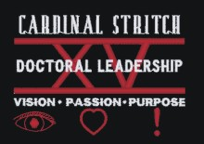
As I enter new opportunities that have presented themselves this year, I look forward to new challenges and opportunities that will come my way. As the Director of Professional Development at Messmer Catholic Schools, I am hopeful that I can have an impact on student achievement by helping all teachers become successful in their classrooms. First and foremost I want to see them succeed and have the knowledge needed to reach every student that they encounter.
While I have my own mission and expectations, as I know having a clear direction, goal, or path is essential for successful leadership. However, I must also always remember that while I have that mission or goal, I must keep my mind open to the natural chaos that will occur. I must remain flexible in order to let the direction carve it's own path as well. It is always important to remember that what matters most is the small impacts that you can make. As those small impacts increase, the overall impact becomes larger and larger. It must start with genuine care and concern for each individual, teacher and students.
As shared by Perez (2009, June), Robinson (2009, June), and Taulbert (2009, June), I will remember that my main focus must be on developing relationships with those I work with. Each and every interaction has the opportunity to bring us together and to work toward our common mission. That interaction might also tweak or refine our understandings of the mission and lead us in new directions as well.
Leadership really is a fine balance of two mutually exclusive events, having a clear direction and mission, and allowing the flexibility for chaos to occur and a new direction present itself. It really is like the understanding of our brain, our left brain focusing on order, and our right brain looking at big picture and pushing to let new realities and understandings emerge.
Having a basic understanding of how our brains work and how people learn can no longer be ignored. In working with teachers to improve instruction, the relationship that is formed with be the basis for understanding what types of past experiences have shaped a teachers' thinking. It is only then that you can purposefully begin to build new neural networks for the teacher, in hopes that the information presented will become automatic enough that it will help students to achieve in that classroom. Many administrators think/feel that when professional development is presented, teachers should just be able to take that information and apply it to their classroom instruction. What we know now is that our brains just don't work that way. The new information has to connect to prior meanings and experiences (Wolfe, 2009; Estes, 2009). Since we all differ in those experiences, it is important to work with each teacher at a more individual level. Helping to shape their experiences, and to build the experiences for them.
It will be essential in moving forward that I remain true to what I want to accomplish, and at the same time leave enough room for random events to occur and take me in different directions.
- I must keep dreaming big at possibilities that didn't occur before (Wild Ideas about Education).
- I must use what I know about learning (Learning is Essential to Leading).
- I must allow random events to occur in my life (Leadership as a Random Set of Events).
- I must take those leadership lessons and continually reflect on how I can put them into my practice (Leadership lessons).
It will be an exciting year full of opportunities. I can honestly say, I don't know what it will look like when I am done, but the journey will be full of new relationships built and new lessons learned!
Estes, D. (2009, June). Brain Power. Lecture delivered at Summer Institute at Cardinal Stritch University, Milwaukee, WI.
Perez, J. (2009, June). Power of diversity leadership. Lecture delivered at Summer Institute at Cardinal Stritch University, Milwaukee, WI.
Robinson, E. (2009, June). Four giant steps to leadership. Lecture delivered at Summer Institute at Cardinal Stritch University, Milwaukee, WI.
Taulbert, C. (2009, June). Leadership for the 21st century. Lecture delivered at Summer Institute at Cardinal Stritch University, Milwaukee, WI.
Wolfe, P. (2009, June). Brain research and education: The vital connection. Lecture delivered at Summer Institute at Cardinal Stritch University, Milwaukee, WI.







